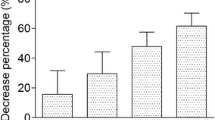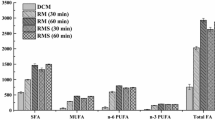Abstract
High-throughput n-3 fatty acid profiling is enabled by collection techniques such as venous whole blood and fingertip prick (FTP) sampling, but the resulting increased sample numbers increases storage demand. Highly unsaturated fatty acids (HUFA) in erythrocytes are susceptible to oxidation, but this tendency is poorly characterized in venous and FTP whole blood. Presently, whole blood samples with low and high n-3 content collected with ethylenediaminetetraacetic acid were stored on chromatography paper with and without BHT pre-treatment for up to 180 days at different temperatures (room, 4, −20, −75 °C). Whole blood prepared with heparin and BHT and stored in cryovials was also examined. Eicosapentaenoic acid (EPA, 20:5n-3) + docosahexaenoic acid (DHA, 22:6n-3) is relatively stable when stored at −75 °C under various conditions but rapidly decreases in whole blood when stored at −20 °C. At −20 °C, BHT + heparin prepared whole blood can prevent decreases in cryovials up to 180 days but BHT only slows the decreases on chromatography paper. Surprisingly, whole blood stored at 4 °C and room temperature was less susceptible to decreases in EPA + DHA as compared with −20 °C storage. Assessments of n-3 blood biomarkers indicate the % n-3 HUFA in total HUFA was more stable as compared with the sum of the relative % of EPA + DHA. In conclusion, FTP and venous whole blood for fatty acid analysis should be stored at −75 °C whenever possible. In the absence of −75 °C storage conditions, BHT should be added and 4 °C or room temperature appear to be better alternatives to −20 °C.




Similar content being viewed by others
Abbreviations
- ARA:
-
Arachidonic acid
- BHT:
-
Butylated hydroxytoluene
- DHA:
-
Docosahexaenoic acid
- EDTA:
-
Ethylenediaminetetraacetic acid
- EPA:
-
Eicosapentaenoic acid
- FTP:
-
Fingertip prick
- HUFA:
-
Highly unsaturated fatty acid
- PUFA:
-
Polyunsaturated fatty acid
References
Stark KD (2008) Analytical implications of routine clinical testing for omega-3 fatty acid biomarkers. Lipid Technol 20:177–179
Marangoni F, Colombo C, Galli C (2004) A method for the direct evaluation of the fatty acid status in a drop of blood from a fingertip in humans: applicability to nutritional and epidemiological studies. Anal Biochem 326:267–272
Min Y, Ghebremeskel K, Geppert J, Khalil F (2011) Effect of storage temperature and length on fatty acid composition of fingertip blood collected on filter paper. Prostaglan Leukot Essent Fat Acid 84:13–18
Metherel AH, Hogg RC, Buzikievich LM, Stark KD (2013) Butylated hydroxytoluene can protect polyunsaturated fatty acids in dried blood spots from degradation for up to 8 weeks at room temperature. Lipids Heal Dis 12:22
Bell JG, Mackinlay EE, Dick JR, Younger I, Lands B, Gilhooly T (2011) Using a fingertip whole blood sample for rapid fatty acid measurement: method validation and correlation with erythrocyte polar lipid compositions in UK subjects. Br J Nutr 106:1408–1415
Stokol T, Nydam DV (2005) Effect of anticoagulant and storage conditions on bovine nonesterified fatty acid and beta-hydroxybutyrate concentrations in blood. J Dairy Sci 88:3139–3144
Agostoni C, Galli C, Riva E, Colombo C, Giovannini M, Marangoni F (2005) Reduced docosahexaenoic acid synthesis may contribute to growth restriction in infants born to mothers who smoke. J Pediatr 147:854–856
Agostoni C, Galli C, Riva E, Rise P, Colombo C, Giovannini M, Marangoni F (2011) Whole blood fatty acid composition at birth: from the maternal compartment to the infant. Clin Nutr 30:503–505
Fratesi JA, Hogg RC, Young-Newton GS, Patterson AC, Charkhzarin P, Block TK, Sharratt MT, Stark KD (2009) Direct quantitation of omega-3 fatty acid intake of Canadian residents of a long-term care facility. Appl Physiol Nutr Metab 34:1–9
Bailey-Hall E, Nelson EB, Ryan AS (2008) Validation of a rapid measure of blood PUFA levels in humans. Lipids 43:181–186
Marangoni F, Colombo C, Galli C (2005) A method for the direct evaluation of the fatty acid status in a drop of blood from a fingertip in humans. World Rev Nutr Diet 94:139–143
Metherel AH, Armstrong JM, Patterson AC, Stark KD (2009) Assessment of blood measures of n-3 polyunsaturated fatty acids with acute fish oil supplementation and washout in men and women. Prostaglan Leukot Essent Fat Acid 81:23–29
Armstrong JM, Metherel AH, Stark KD (2008) Direct microwave transesterification of fingertip prick blood samples for fatty acid determinations. Lipids 43:187–196
Albert CM, Campos H, Stampfer MJ, Ridker PM, Manson JE, Willett WC, Ma J (2002) Blood levels of long-chain n-3 fatty acids and the risk of sudden death. N Engl J Med 346:1113–1118
Moyers B, Farzaneh-Far R, Harris WS, Garg S, Na B, Whooley MA (2011) Relation of whole blood n-3 fatty acid levels to exercise parameters in patients with stable coronary artery disease (from the heart and soul study). Am J Cardiol 107:1149–1154
Di Marino L, Maffettone A, Cipriano P, Celentano E, Galasso R, Iovine C, Berrino F, Panico S (2000) Assay of erythrocyte membrane fatty acids. Effects of storage time at low temperature. Int J Clin Lab Res 30:197–202
Magnusardottir AR, Skuladottir GV (2006) Effects of storage time and added antioxidant on fatty acid composition of red blood cells at −20 °C. Lipids 41:401–404
Otto SJ, Foreman-von Drongelen MM, von Houwelingen AC, Hornstra G (1997) Effects of storage on venous and capillary blood samples: the influence of deferoxamine and butylated hydroxytoluene on the fatty acid alterations in red blood cell phospholipids. Eur J Clin Chem Clin Biochem 35:907–913
Ross MA, Long WF, Williamson FB (1992) Inhibition by heparin of Fe(II)-catalysed free-radical peroxidation of linolenic acid. Biochem J 286(Pt 3):717–720
Ross MA, Long WF, Williamson FB (1992) Heparin reduces Fe(II)-catalyzed peroxidation of linolenic acid. Biochem Soc Trans 20:6S
Morrison WR, Smith LM (1964) Preparation of fatty acid methyl esters and dimethyl acetals from lipids with borontrifluoride-methanol. J Lipid Res 5:600–608
Metherel AH, Taha AY, Izadi H, Stark KD (2009) The application of ultrasound energy to increase lipid extraction throughput of solid matrix samples (flaxseed). Prostaglan Leukot Essent Fat Acid 81:417–423
Stark KD, Salem N Jr (2005) Fast gas chromatography for the identification of fatty acid methyl esters from mammalian samples. Lipid Technol 17:181–185
Harris WS, Von Schacky C (2004) The Omega-3 Index: a new risk factor for death from coronary heart disease? Prev Med 39:212–220
Lands WE (1995) Long-term fat intake and biomarkers. Am J Clin Nutr 61:721S–725S
Stark KD (2008) The percentage of n-3 highly unsaturated fatty acids in total HUFA as a biomarker for omega-3 fatty acid status in tissues. Lipids 43:45–53
Pottala JV, Espeland MA, Polreis J, Robinson J, Harris WS (2012) Correcting the effects of −20 °C storage and aliquot size on erythrocyte fatty acid content in the women’s health initiative. Lipids 47:835–846
Moilanen T, Nikkari T (1981) The effect of storage on the fatty acid composition of human serum. Clin Chim Acta 114:111–116
Ney JG, Koury JC, Azeredo VB, Casimiro-Lopes G, Trugo NM, Torres AG (2009) Associations of n-6 and n-3 polyunsaturated fatty acids and tocopherols with proxies of membrane stability and subcutaneous fat sites in male elite swimmers. Nutr Res 29:623–630
Kolanjiappan K, Manoharan S, Kayalvizhi M (2002) Measurement of erythrocyte lipids, lipid peroxidation, antioxidants and osmotic fragility in cervical cancer patients. Clin Chim Acta 326:143–149
Rai DK, Rai PK, Rizvi SI, Watal G, Sharma B (2009) Carbofuran-induced toxicity in rats: protective role of vitamin C. Exp Toxicol Pathol 61:531–535
Hagve TA, Lie O, Gronn M (1993) The effect of dietary n-3 fatty acids on osmotic fragility and membrane fluidity of human erythrocytes. Scand J Clin Lab Invest Suppl 215:75–84
Hagve TA, Johansen Y, Christophersen B (1991) The effect of n-3 fatty acids on osmotic fragility of rat erythrocytes. Biochim Biophys Acta 1084:251–254
Ambali SF, Ayo JO, Ojo SA, Esievo KA (2010) Vitamin E protects Wistar rats from chlorpyrifos-induced increase in erythrocyte osmotic fragility. Food Chem Toxicol 48:3477–3480
Ambali SF, Ayo JO, Ojo SA, Esievo KA (2011) Ameliorative effect of vitamin C on chronic chlorpyrifos-induced erythrocyte osmotic fragility in Wistar rats. Hum Exp Toxicol 30:19–24
Cardenia V, Rodriguez-Estrada MT, Cumella F, Sardi L, Della CG, Lercker G (2011) Oxidative stability of pork meat lipids as related to high-oleic sunflower oil and vitamin E diet supplementation and storage conditions. Meat Sci 88:271–279
Health Canada (2012) Canadian nutrient file, version 2010 http://webprod3.hc-sc.gc.ca/cnf-fce/index-eng.jsp. Accessed July 2012
Halliwell B, Chirico S (1993) Lipid peroxidation: its mechanism, measurement, and significance. Am J Clin Nutr 57:715S–724S
Sowemimo-Coker SO (2002) Red blood cell hemolysis during processing. Trans Med Rev 16:46–60
Acknowledgments
Operating funds were provided by the Natural Sciences and Engineering Research Council to K.D.S. Infrastructure was purchased through Canada Foundation of Innovation and the Ontario Research Fund matching grants.
Author information
Authors and Affiliations
Corresponding author
About this article
Cite this article
Metherel, A.H., Aristizabal Henao, J.J. & Stark, K.D. EPA and DHA Levels in Whole Blood Decrease More Rapidly when Stored at −20 °C as Compared with Room Temperature, 4 and −75 °C. Lipids 48, 1079–1091 (2013). https://doi.org/10.1007/s11745-013-3827-x
Received:
Accepted:
Published:
Issue Date:
DOI: https://doi.org/10.1007/s11745-013-3827-x




